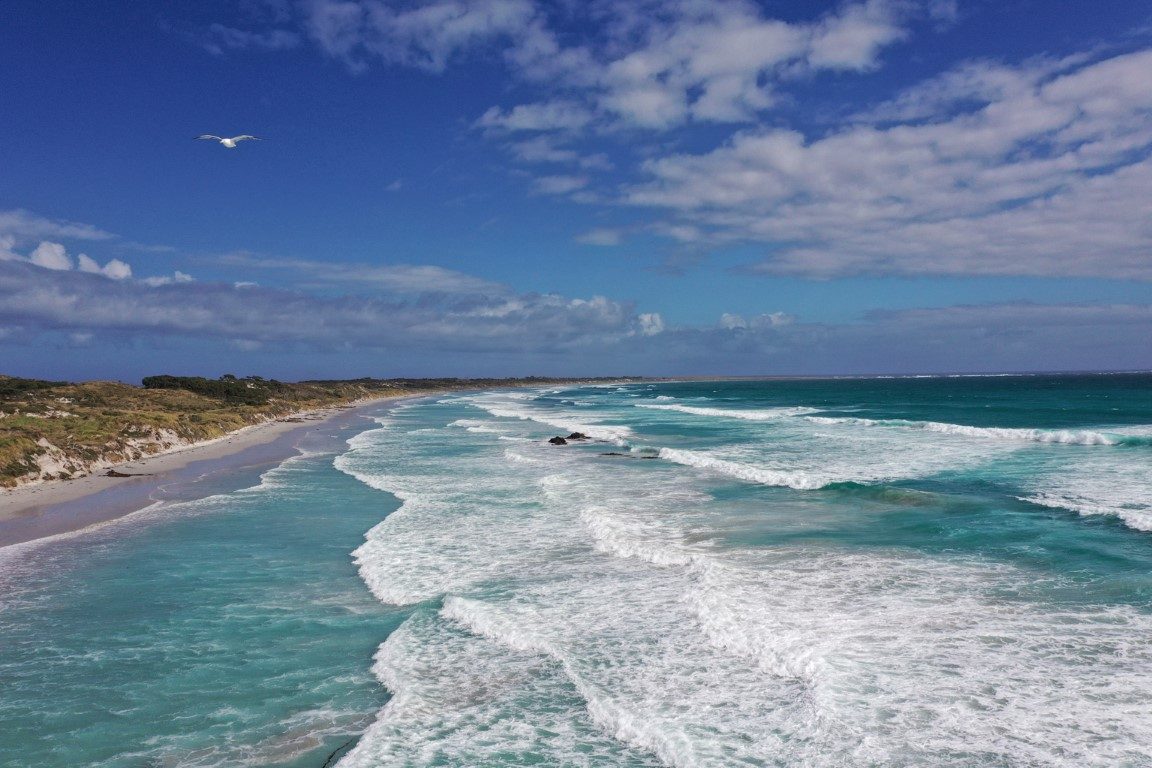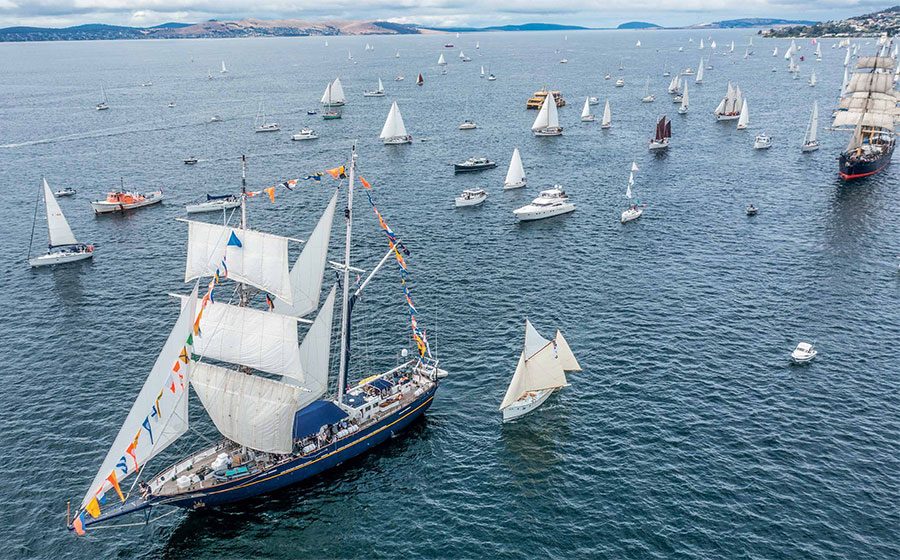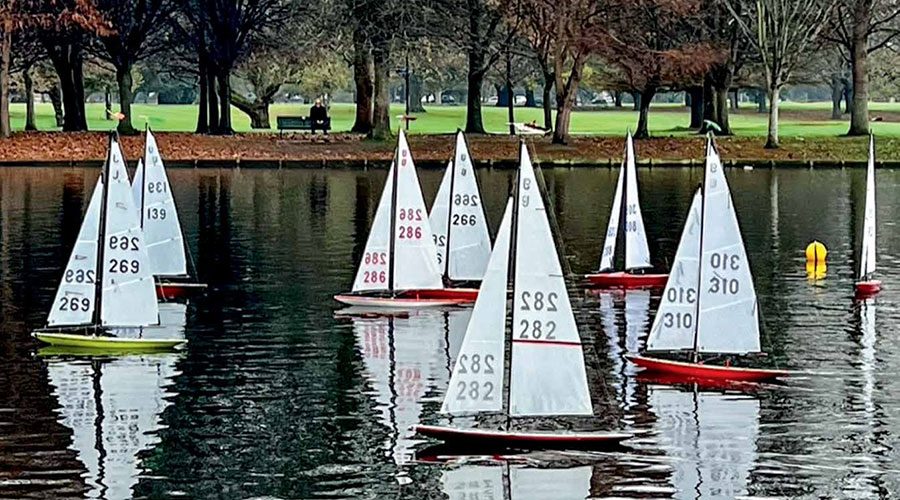

The Chatham Islands are remote, rugged and raw – there’s few other ways to describe them. Tom Fraser recounts a week spent at this remarkable location.
Yes, the ‘Chats’ are isolated but with regular flights from Auckland, Wellington and Christchurch on a comfortable Air Chathams aircraft, access has become easier in recent years. And, its popularity as a tourist destination for Kiwis has increased significantly since the COVID pandemic temporarily ended international travel. Earlier this year, my 15-year-old son Angus and I had the opportunity to visit Dylan and Kane Shaw, extended family living and working on the main island, and what we saw and experienced left us wanting more trips in the future.

Despite all the background reading and internet sleuthing, there was still some trepidation as we checked in bags, rods and freediving equipment one February morning at Christchurch Airport. I really did feel we were venturing into the unknown. While passengers can individually check in 23kg of luggage, the excess gear that most divers or anglers require could hit you harder in the pocket – in our case by well over $300.
As we boarded the aircraft I noticed that Angus and I both had the same allocated seat and I made a mental note to mention this to the flight attendant. However, as soon as we stepped onboard she said simply, “Welcome aboard, sit wherever you like.” Welcome to the Chats…
Our ATR72 aircraft tracked north from Christchurch for a short while before turning right and flying 800km east for a little over two hours. The first half hour offered spectacular views of Banks Peninsula and provided a great perspective of its size and location relative to the Canterbury Plains. Later, you could look out the window to the Pacific Ocean 5000-plus metres below and just make out fishing boats working the waters, a reminder of the productivity of these fishing grounds to the east of the mainland.
The first thing we observed as we descended towards the island (known as Rēkohu in Moriori and Wharekauri in Maori) was how big and flat it appeared, something that became even more obvious as we explored it over the next few days. It is in fact an archipelago of about 10 islands, but the main island, with Pitt Island, are the only ones inhabited or accessible. The many volcanic cones you see dotted across the island are evidence of how the archipelago was created millions of years ago.

Angus and I played tourists for the first couple of days before my wife’s cousin Dylan – a fishing boat skipper – was free to help us experience some ‘real’ Chatham Islands’ experiences. This included spending a huge amount of time fishing, diving and simply exploring some of the islands’ many special spots.
Around Rēkohu we caught cod aplenty using softbaits, jigs and fresh bait, including paua and crayfish. But, to be honest, the fish aren’t fussy – people have caught cod with muesli bar wrappers on hooks. Moki too, were often caught, unable to resist crayfish bait cast their way.
We fished from sandy beaches, off the rocks, from a boat, as well as off the concrete x-blocks that make up the new seawall of the redeveloped port at Waitangi. Just five years old, the new port was a mammoth undertaking and involved reclamation of 9,500m2 of land, construction of new commercial and fishing wharves, and a 180m-long seawall/breakwater.

One of Dylan’s mates’ has a farm along the south coast and we were fortunate to be able to cross his land to fish off the rocks and explore the rugged seascape and spectacular rock pools at low tide. Here, large paua and kina could be collected while wearing jandals and shorts.
We knew there were kingfish around but were unable to connect with any, and this was in part due to some rough weather we experienced. Huge, surging swells rolled in from the west for several days, followed by a cold, wet southerly, so the water remained murky for some time. Interestingly, fishermen say the number of kingies observed and caught over recent years has increased significantly and they’re now being caught in some very unusual and unexpected places around the islands. Climate change? Who knows?
A popular way to get onto the water to fish is to utilise one of the island’s charter boats – your accommodation provider will have a list of potential options. It goes without saying that the internet, too, offers plenty of information even before you leave the mainland.

We watched crews catch crays and fish, move pots and expertly navigate the challenging conditions. It was the final week before the month-long closure of the cray fishery, so fishers around the island were busy hauling pots from the water. Once on land, the pots get some TLC in preparation for the new season.
We also had the opportunity to experience some ‘traditional’ Chatham Island fishing. Handlines are the preferred method and these consist of a long rope, any weight available (in our case an old dive weight) and several large hooks baited with cod branching off the rope. It’s not hāpuku (groper) fishing as we know it on the mainland. In fact, the setup couldn’t be further from what we’re used to.
Once the boat was positioned over the mark the ropes were dropped over the side. Within seconds of reaching the bottom, you’d feel a solid couple of tugs to signal your hook-up. Then, it was simply a case of hauling the rope back onto the deck! We caught fish up to 20kg using this method – and in 20m of water! Largely unheard of back home. And because it’s shallow, any unwanted hāpuku can be safely and easily returned to the briny.
It goes without saying that seafood is a staple for islanders. Dylan’s partner Andy is a chef and she prepared a seafood feast that was the most memorable meal of my life. The appetiser of crayfish and paua spring rolls was followed by a main course that included cod, hāpuka, whitebait, crayfish salad and moki.
I don’t think I’ll ever eat a meal like it again.

The diving is quite exceptional when conditions allow. Angus and I are learning the art of freediving and I doubt there are any other places better to gain experience, confidence and knowledge. The water is often gin-clear and crayfish, kina and paua are abundant. Schools of moki, cod and other species swim close to investigate and, on one occasion, we had kingies swim around us. Unfortunately, we’d had some bad luck and had damaged our speargun a couple of days earlier. Despite our best efforts, we hadn’t been able to repair it or find replacement parts.
That illustrates a point to remember if you do visit the island – take plenty of spare gear, whether it’s sinkers, lures or line – pack what you can. And, if you don’t need it while you’re there, leave it with a local. If you’re considering a trip and hope to fish, pack a solid, versatile rod that’s capable of casting off the rocks, or from a sandy beach. Our softbait rods were limited in what they could do, but our larger, more powerful rods got plenty of use.
After one spectacular and memorable dive we sat on the beach soaking up the sun, sipping a beer and yarning away. Dylan set up the BBQ and we enjoyed fresh pipis, paua and cod caught just minutes earlier. Seriously, life doesn’t get much better.

Commercial fishing is the island’s lifeblood and Waitangi – the main town – is where most of the fishing vessels are based, either anchored in the bay or resting on trailers on the shore beside one of the island’s several fish factories. The port can be a great spot to sit and watch the world go by; Angus and I often sat and watched the fishing boats come and go and talked with their crews as their catch was unloaded. They were always happy to chat, and talked of tides, moons, feet and fathoms, reefs and shoals. Fishers we met were incredibly hardworking and passionate about their job and also about the fishery. Owenga, about 20 minutes’ scenic drive from Waitangi, is also a base for fishing boats. Again, some rest on their moorings in the bay while others sit on trailers on the beach.

The village of Kaingaroa, at the northeast tip of the island, felt like the end of the earth. It’s a long, dusty drive from Waitangi and homes there cling to any shelter out of the wind. One of the island’s two primary schools is there (teenagers generally attend secondary school in New Zealand) and it’s also the location of the ‘world famous’ Kai Kono Café/Takeaway. There are some accommodation options in Kaingaroa and its renowned for providing access to some superb fishing. A number of commercial fishing boats are based there, some anchored in the bay and others on trailers on the beach.
All this travelling the dusty rods had proven thirsty work, so we popped in to the Social Club, purchased some beers and sat on the nearby wharf. The clarity of the water from our vantage point was astonishing and we could clearly see paua, cod, moki, and wrasse gently moving around the piles. Kaingaroa is a fantastic location and we loved it.
The equally long drive out to Waitangi West takes you past the small community of Port Hutt, the spot where Māori first landed in 1835 (hundreds of years after the incumbent Moriori people). You can’t miss the wreck of the former minesweeper/fishing vessel Thomas Currell in the bay. Port Hutt became a busy whaling, trading and fishing station and, in 1874, American scientists observed the Transit of Venus there.

A bit further on from Port Hutt is the Maunganui Stone Cottage, a 30-minute walk from the road, and one of the most popular spots for visitors to venture. It was built in 1866 by German Moravian missionaries who first arrived on the island in the early 1840s. The incredible cultural and geological history of the island is abundantly clear at every turn as you explore the Chats.
We didn’t get out for a pig hunt, but evidence of the introduced animals is widespread. The damage they’ve done to farmland and conservation areas is quite remarkable and hunting is not only an important tool to control numbers, but also a popular social activity for many residents.
Neither did we get to nearby Pitt Island; the small Cessna flying the 25-minute hop was undergoing maintenance and the swell at that time was too formidable to try by boat. Did we feel cheated? Not at all. There were plenty of adventures and activities to do on the ‘mainland’. A day-trip to Pitt costs over $400 per person.
The reality is the Chathams can be difficult to explore; rental cars are expensive (at least $200 per day), there are very few roads and most of the land (and beaches/coast) is privately owned and closely guarded. Unless you know exactly who to contact, access can be challenging. You can’t simply arrive on the island with a pack, tent and gas cooker and expect to hitch around and camp on any beach or bare land. There are no camping grounds, backpacker lodges or the like, full stop.

Nonetheless, there are accommodation options; we stayed in the Traveller’s Rest, an historic house owned by the Chatham Islands Hotel (which owns and offers a selection of accommodation options). With its own kitchen and lounge, this provided us greater independence. The $350 tariff per night (roughly similar across the board) included breakfast in the hotel, an easy three-minute walk down the hill. We also enjoyed dinner in the hotel several times – first-class food at similar prices to a restaurant meal back home in Canterbury.
Almost every visitor we met or saw during our stay was on an organised tour; each day they’d board a tour bus and visit locations such as the Maunganui Stone Cottage, basalt columns, Cape Munning seal colony and Kopinga Marae as part of a set itinerary. I think it’s fair to say that residents have diverse and often strong feelings about the increased numbers of tourists over recent years and their impact on the economy and fishery. Fortunately, our family connections meant we were treated somewhat differently and provided with opportunities many visitors wouldn’t get.

Our highlights were the simple things that didn’t cost a cent: a walk along the windswept beach at Maunganui or the breath-taking panorama of Petre Bay from Te Whenuhau Hill. The new museum in Waitangi is worth a visit; on a wet day teenage Angus was happy to spend several hours investigating artefacts and displays detailing the incredibly rich history of the islands and their people.
Another feature was pulling off the road for a walk along the beaches of Te Whanga Lagoon, an expanse of water a bit smaller than Canterbury’s Te Waihora/Lake Ellesmere. It was here that Dylan showed us how to look closely and carefully and differentiate the pebbles, shells and other flotsam from the small ancient, fossilised sharks’ teeth scattered there.

The Chathams are not a place to visit if you want to sip oat-milk cappuccinos every morning or perouse boutique shops for mementos to take home. But, if you’re prepared to get outside, be adventurous, walk and explore, then it’s definitely worthwhile visiting. My strongest suggestion is to be prepared to expect the unexpected and ‘go with the flow’.
Our week on the island flew by and the early morning drive to the airport to catch our departing flight was quiet. I think Angus and I were both reflecting on a remarkable week we knew would provide stories and memories for years to come. We both felt incredibly grateful for the chance to visit and for the opportunities we were offered.
The residents of the Chats are proud, resilient, resourceful and passionate guardians of their unique landscape and waters. If you get the opportunity to visit their island, by all means take it, but remember to be grateful and gracious.





